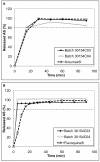The initial pharmaceutical development of an artesunate/amodiaquine oral formulation for the treatment of malaria: a public-private partnership
- PMID: 21605361
- PMCID: PMC3128010
- DOI: 10.1186/1475-2875-10-142
The initial pharmaceutical development of an artesunate/amodiaquine oral formulation for the treatment of malaria: a public-private partnership
Abstract
Background: Artemisinin-based combination therapy is currently recommended worldwide for the treatment of uncomplicated malaria. Fixed-dose combinations are preferred as they favour compliance. This paper reports on the initial phases of the pharmaceutical development of an artesunate-amodiaquine (ASAQ) bilayer co-formulation tablet, undertaken following pre-formulation studies by a network of scientists and industrials from institutions of both industrialized and low income countries.
Methods: Pharmaceutical development was performed by a research laboratory at the University Bordeaux Segalen, School of Pharmacy, for feasibility and early stability studies of various drug formulations, further transferred to a company specialized in pharmaceutical development, and then provided to another company for clinical batch manufacturing. The work was conducted by a regional public-private not-for-profit network (TropiVal) within a larger Public Private partnership (the FACT project), set up by WHO/TDR, Médecins Sans Frontières and the Drugs for Neglected Disease initiative (DNDi).
Results: The main pharmaceutical goal was to combine in a solid oral form two incompatible active principles while preventing artesunate degradation under tropical conditions. Several options were attempted and failed to provide satisfactory stability results: incorporating artesunate in the external phase of the tablets, adding a pH regulator, alcoholic wet granulation, dry granulation, addition of an hydrophobic agent, tablet manufacturing in controlled conditions. However, long-term stability could be achieved, in experimental batches under GMP conditions, by physical separation of artesunate and amodiaquine in a bilayer co-formulation tablet in alu-alu blisters. Conduction of the workplan was monitored by DNDi.
Conclusions: Collaborations between research and industrial groups greatly accelerated the process of development of the bi-layered ASAQ tablet. Lack of public funding was the main obstacle hampering the development process, and no intellectual property right was claimed. This approach resulted in a rapid technology transfer to the drug company Sanofi-Aventis, finalizing the process of development, registration and WHO pre-qualification of the fixed-dose co-formulation together with DNDi. The bi-layered tablet is made available under the names of Coarsucam® and Artesunate amodiaquine Winthrop®, Sanofi-Aventis. The issue related to the difficulty of public institutions to valorise their participation in such initiative by lack of priority and funding of applied research is discussed.
Figures







References
-
- WHO. Global anti-malarial drug policy database, Africa. WHO; 2009. http://www.who.int/malaria/am_drug_policies_by_region_afro/en/index.html
-
- Millet P. [TropiVal: Lessons learned from attempts to valorize public research and development of new therapies for control of tropical disease] Med Trop (Mars) 2004;64:441–443. - PubMed
-
- Croft SL. Public-private partnership: from there to here. Trans R Soc Trop Med Hyg. 2005;99(Suppl 1):S9–14. - PubMed
Publication types
MeSH terms
Substances
Grants and funding
LinkOut - more resources
Full Text Sources
Other Literature Sources
Medical

